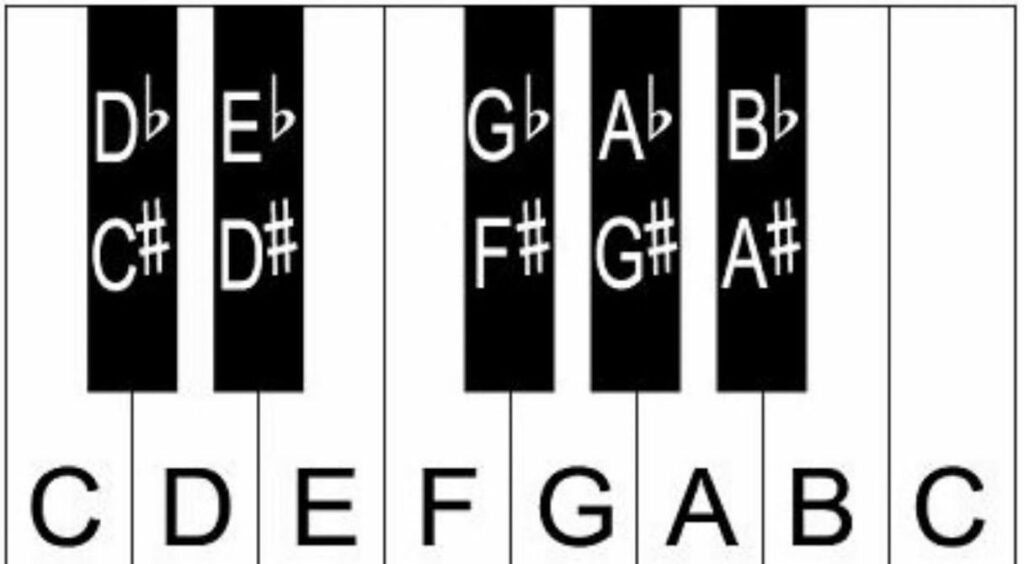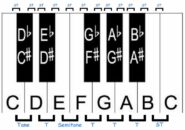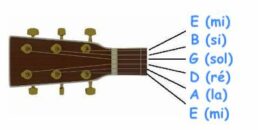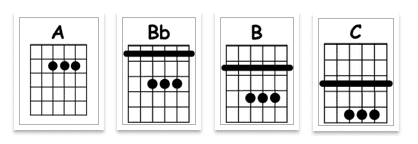Tutorial with explanations to learn the all notes guitar fretboard.
En esta página encontrará
Scale notes

“The scale notes” is an expression that does not mean much. Indeed, each scale is different and the notes are differents (some are played, others not).
But we can schematize and say that, in Western music, the frequencies are materialized and divided into notes of which the main ones are Do, Ré, Mi, Fa, Sol, La and Si
Learn more :
Instead of talking about notes, it is much more useful and understandable to talk about intervals.
Each scale (major, minor, major 7, minor 7, etc…) is indeed defined by particular intervals between the notes which start from the first note : the tonic.
Thus, all the identical scales (major for example) have the same intervals, whether it is the scale of C, D, E, etc… Without knowing the notes, one can thus play a scale according to the intervals.
The letters of notes
The notes, which we call Do, Ré, Mi, Fa, Sol, La and Si in some countries have an international symbol that comes from English and takes the form of letters.
These letters are important to know because it is very common to find the names of notes and chords in the form of letters.

To know and learn these letters, it is quite simple. As you can see on the picture of the piano, the C corresponds to Do. Then you just have to follow the notes of the scale that we have seen.
You can find your way more easily with the F which corresponds to F.
So for the letters of notes we have :
C (do), D (ré), E (mi), F (fa), G (sol), A (la), and B (si).
The interval of notes
As we said, it is often easier to talk in terms of intervals of notes.
Here we won’t talk about music theory but we will see the usefulness of knowing the intervals between the different notes to find your way more easily on the guitar.
As you can see on the picture of the piano we are using (below), the sequence of notes is not left to chance. Each note is separated by an interval.
There are two types of intervals :
- the tones (which I symbolized by the T)
- the semitones (symbolized by the ST)

It is quite explicit to take the example of the piano keyboard to understand this story of interval.
Indeed, if you look closely, between the white notes (at the bottom of the keyboard) there is almost always a black note. These are the main notes (Do, Ré, Mi, Fa, Sol, La and Si) that are altered with sharps (#) or flats (b).
Learn more :
Besides, you can notice that the C# corresponds to the Db. We will use one of the two depending on the alteration we wish to give, depending on whether we go up or down the scale : either we try to decrease the D (and we end up with a Db), or we try to increase the C (and we end up with a C#)
Briefly :
- Between each white note and each black note, there is a semitone
- Between each white note, there is almost always a full tone…
- … except when there is no black note between two white notes (which happens between E and F as well as B and C) : there is then a semitone
What will interest us for the guitar is to understand this sequence between the notes of the scale and their alterations.
The sequence of notes by semitones
You must therefore remember this sequence of notes by semitones as seen on the piano :
C – C# – D – D# – E – F – F# – G – G# – A – Bb – B
Guitar string notes
When this sequence of notes is well understood, we will be able to move on to practice and see how it materializes with the guitar.
Before looking at the notes of the guitar, you need to know the notes of the open strings (i.e. the frequency at which you have to tune them before playing).
Indeed, when you sound one of your strings without pressing the neck, the sounds correspond or at least should correspond (if you are tuned in this way) to the following notes :

It’s quite simple and to know by heart to understand the end of our tutorial : the guitar notes.
Don’t forget to use our guitar tuner to be just.
All notes on the guitar fretboard
To finish our tutorial, we will take everything we have seen and apply it to the guitar neck.
Reminder before concluding:
- The musical notes follow a logic of frequency and are called : C (do), D (ré), E (mi), F (fa), G (sol), A (la), and B (si)
- These notes can have alteration (# or b) that make them vary and increase (#) or decrease (b) the note by a semitone
- The sequence of notes by semitones is : C – C# – D – D# – E – F – F# – G – G# – A – Bb – B
You can now look at this guitar neck :

3 things to notice:
- As you can see on the left, we have the notes of the open strings : E – A – D – G – B – E
- If we go up the neck to the right, we have a sequence of notes, which, if you look carefully, corresponds to our sequence of notes by semitones (C – C# – D – D# – E – F – F# – G – G# – A – Bb – B)
- Finally, you can notice that I stopped at the 5th fret because, for most strings, this is the moment when the note corresponds to the next open string (except for the G string where it is at the 4th fret)
If you have remembered the names of the open strings and the sequence of notes by semitones, you should be able to know the notes on the neck all the way to the end of the neck.
You just have to remember that between the E and the F as well as the B and the C there is only one semitone (i.e. no alteration).
Then you just have to recite this sequence to find your notes from the open string.
Exemple :
I take the second string from the top that is (if you are tuned) the A string.
If I advance to the third fret without going beyond it, I have to know with the help of my note sequence by semitones where I am:
A – Bb – B – C (and I stop before the 4th fret)
So, going back to our YouTube tutorial on chords positions, look at the chord of A whose bass is the 2nd open string (i.e. note A) :

You will understand that, if I make a barre chord and I move on the neck to the right keeping the same position, my chord changes according to the sequence of notes by semitones.
So I would have the following chords :

